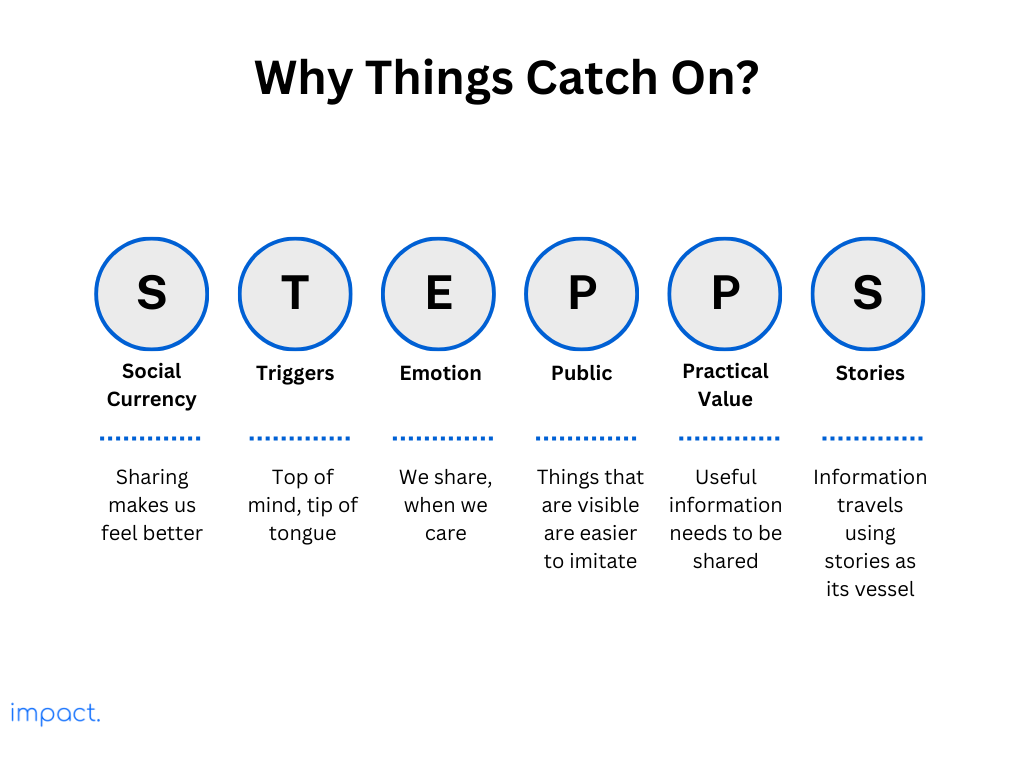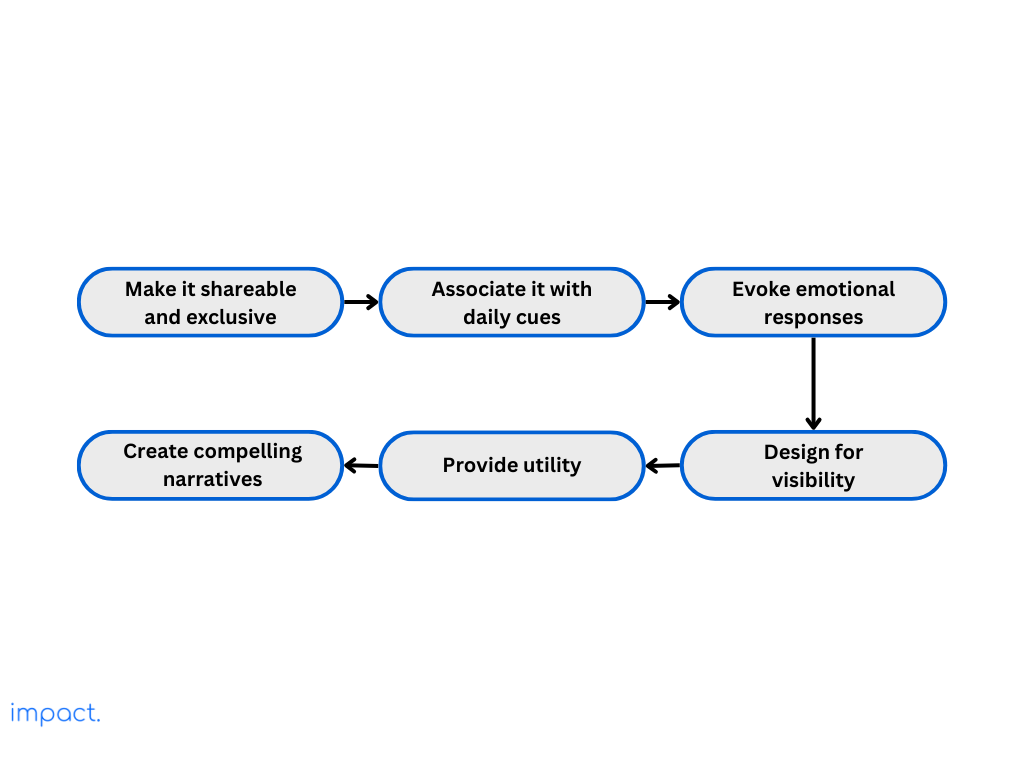Kanban: Definition, 6 Rules, and its Benefits
Kanban is a crucial part of the Just in Time (JIT) system, which we discussed…
Sean Thobias
May 17, 2025Word of mouth heavily influences 20-50% of purchasing decisions, but surprisingly, only about 7% of it occurs online, as per research by the Keller Fay Group.
To make things popular, you need virality. This article breaks down the concept and guides you on achieving virality using Jonah Berger’s six key elements (STEPPS) from his book “Contagious – Why Things Catch On“: Social Currency, Triggers, Emotion, Public, Practical Value, and Stories.
Virality is how fast and far something, like a message or content, spreads among people, often through word of mouth, social media, or online platforms. When something goes viral, it grabs much attention, and many people share it fast.
Knowing virality is crucial for marketers, content creators, and anyone aiming to reach a big audience with their message or product. Yet, predicting what will go viral is challenging since it hinges on unpredictable factors.
Creating viral content means your ideas get shared without spending much on ads. It usually spreads through social media, word of mouth, and online platforms.
Viral content often prompts user-generated content, which about 85% of consumers find more influential than brand visuals. You can save money on marketing by gaining visibility and organic following without paid promotions.
Creating viral content can quickly connect with a vast audience. When your audience shares this content, it expands beyond your initial target, helping you reach new markets and demographics not easily reached through traditional marketing.
This extensive reach is crucial for boosting brand exposure and increasing sales. Simplifying the sharing process, such as adding social media buttons or providing easy-to-copy links on your website, encourages more people to spread your message.
Viral content grabs much attention, boosting how well people know your brand. People sharing and interacting with your content get to know your brand and its offerings.
More exposure helps people remember your products or services when deciding what to buy. Going viral also builds a positive image for your brand, making your business stand out as trustworthy and well-known.
When content goes viral, it brings people who share an interest in or connection to the brand. Virality sparks conversations and interactions on social media and in person, fostering customer loyalty and a sense of community.
Active involvement leads to a more dedicated customer base. In fact, 73% of companies rely more on existing customers than exploring new markets.
The more your content goes viral, the more it shows potential customers that your brand is worth noticing. When people see others sharing and interacting with your content, it builds credibility and authenticity.
This social proof boosts consumer trust and buying choices. A better brand reputation can attract customers to choose your products/services over competitors.
Jonah Berger discovered six fundamental principles that often make messages, products, and ideas spread widely. These are the STEPPS principles:


Create shareable and exclusive content to boost your brand’s virality. Introduce limited-time promotions or exclusive sneak peeks to create urgency and motivate users to share for exclusivity.
Leverage social media and offer incentives like discounts or special access to amplify content sharing. Find the sweet spot between shareability and exclusivity to ensure your content spreads while maintaining a coveted user experience.
To seamlessly integrate your brand into your audience’s daily life, align your content with their habits and interests. Identify their regular activities and craft content that effortlessly blends into their routines.
Enhance your brand’s connection by producing timely, relevant content that ties your messages to current discussions or events. This integration into your audience’s daily routine strengthens the bond with them
Intense emotions, whether good or bad, push people to take action. While positive news tends to be shared more, articles that make readers angry or anxious get passed around.
Understand what emotions resonate with your audience and adjust your content strategy accordingly. Creating emotional ties helps your brand stick in people’s minds, encouraging them to share their emotional stories with others.
Since most people process 90% of information visually and 65% are visual learners, the appearance of your content is essential for grabbing attention and making it go viral.
Create content that looks great, is easy to understand, and can be shared on different platforms. Use your brand’s imagery consistently to build a recognizable look that engages with people wherever they are.
Create content that solves problems, fulfills needs, or shares valuable information. Whether it’s guides, videos, or tips, valuable content establishes your brand as an authority.
Know your audience’s problems and challenges to tailor your content for them. Consistently providing value makes your brand a go-to resource, building loyalty and prompting users to share positive experiences.
Create captivating stories to grab your audience’s attention and make your brand go viral. Develop a narrative that ties together your brand’s history, customer experiences, or related content pieces.
Make your content share-worthy by creating episodic stories that keep users returning for more. Encourage user engagement with interactive elements or content that invites them to be part of the narrative.
Conduct in-depth research to discover your audience’s preferences, behaviors, and preferred communication channels. Understand what appeals to them, identify their pain points, and recognize valuable content.
Failure to comprehend your audience may lead to a misalignment between your brand message and your audience’s values. Ensure your content resonates with your audience to avoid this mismatch and effectively communicate your brand message.
Consistency in your brand is vital for trust and recognition, with Lucidpress stating it can boost revenue by 10-20%. This involves keeping visual elements, tone, and messaging consistent across all platforms.
A consistent brand builds a clear and memorable identity, helping your audience easily recognize and share your content. Conversely, inconsistency can erode trust and impede your brand’s viral potential.
Authenticity matters to 88% of consumers when choosing brands. People are more likely to share content that feels real and relatable.
Avoid deceptive tactics like exaggerating product benefits or pretending to support a cause without genuine commitment. Inauthenticity can harm a brand’s credibility, leading to negative reviews, decreased loyalty, and reduced chances of virality.
Diversify your content strategy to reach more people. Use a mix of images, videos, blogs, and interactive content because everyone likes different things.
Experiment with various topics and styles to find what your audience likes best. If you don’t vary the content, your audience may lose interest, resulting in less sharing.
Regularly check how well your content is doing by looking at engagement, shares, and conversions. Learn from what works and improve your strategy for creating content that gets shared more.
Consider using software like an ERP that centralizes data from different departments; this can be incredibly useful for marketing teams to analyze customer behavior, track trends, and find opportunities for brand promotion.
Stay updated with trends and include them in your content strategy to keep your brand visible and relatable. Watch for industry trends, popular hashtags, and cultural happenings for timely and relevant content opportunities.
Ignoring trends can make your brand seem outdated, reducing your content’s shareability and viral potential. Stay relevant to avoid appearing out of touch with your audience.
In 2015, Apple’s ‘Shot on iPhone’ campaign showcased the superior camera quality, creating a buzz on social media and sparking a content creation trend. The campaign’s success, fueled by memes, positioned Apple as the top choice for camera enthusiasts, highlighting its innovative approach to brand presence and product quality.
Here’s an analysis of its virality using the STEPPS principles:
The ALS Ice Bucket Challenge became a worldwide viral sensation to boost awareness and funds for ALS research. Celebrities like Bill Gates and Oprah Winfrey joined in, pouring ice water on themselves and raising over $220 million, with a lasting 25% increase in contributions even after the campaign concluded.
Here’s an analysis of its virality using the STEPPS principles:
The STEPPS framework is a thorough guide for grasping and utilizing the components that drive the contagious spread of ideas. Yet, predicting virality proves challenging due to numerous unpredictable factors.
Although software like ERP systems and CRM can provide valuable insights by centralizing data, it’s crucial to understand that the core of virality is authenticity. Trying to force content to go viral might bring short-term gains, but a lasting and organic message spread requires a genuine connection with the audience.
Berger, J. (2016). Contagious: Why Things Catch On. Simon and Schuster.
Impact Insight Team
Impact Insights Team is a group of professionals comprising individuals with expertise and experience in various aspects of business. Together, we are committed to providing in-depth insights and valuable understanding on a variety of business-related topics & industry trends to help companies achieve their goals.
See how our ERP provides better value.
Speak with our consultant to explore how we can improve your accounting, processes, and people.
